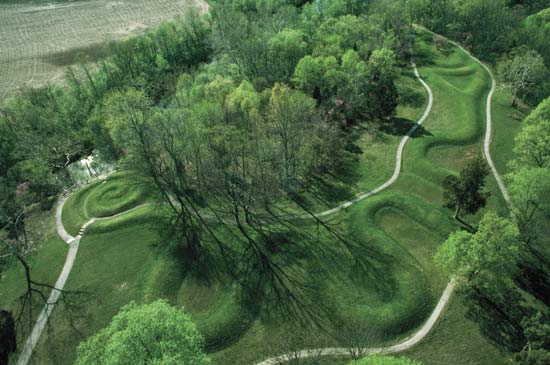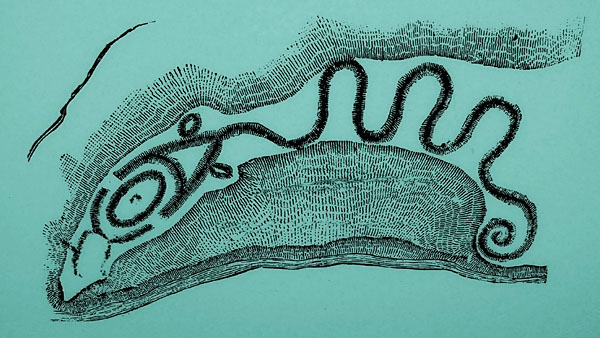Animal Effigies and Indian Mounds June 4, 2011
Author: Beach Combing | in : Ancient, Medieval , trackback
Beachcombing has long been attracted to the so called ‘animal effigy mounds’ of Wisconsin, Iowa, Minnesota, Ohio and Louisiana. Across these states local Indian populations built a series of giant mounds in the shape of animals. Dating is almost impossibly difficult in such cases, but many archaeologists have placed the creation of these mounds in the period 1500 BC to 1500 AD.
The mounds are unusual for several reasons. The most basic question is: why did the nomadic Amerindians find people to construct these great effigies out in the woods? The immediate reaction of archaeologists is to look for dead bodies interred within the mounds, but the mounds were apparently not used for burial. Presumably their use must be put down to that broadest of all markers ‘ritual’.
Then there is the problem of their scale and orientation. These mounds were enormous. Their makers often built them up to thirty or forty feet high and a hundred or a hundred and fifty feet in diameter. And this is not all: these huge objects were clearly placed in relation to each other. The example pictured above (thanks to Ruth for this image) is from McGregor Iowa and shows a possession of bears making their way through the countryside towards two great eagles.
Finally, and Beachcombing is loath to bring this up, there is the problem of how they could have been appreciated before powered flight in the early twentieth century. Like many prehistoric ritual constructions they ‘map’ the land and can only be properly enjoyed from the air: a privilege not available to the Indian populations of mid America in this period.
The only sensible solution to the problem of the effigies that links into the ethnology of North American Indian groups is that the animals portrayed were totem or clan animals. But that still doesn’t explain their positioning in the landscape, nor the ‘story’ they seem to be telling. Other explanations have tried to relate the effigies to food resources or even to subterranean geological freakery. Any other ideas? drbeachcombing AT yahoo dot com
Beachcombing does not have the tools to indulge in such speculation. He will end, however, with a tribute to the effigy builders by describing their most extraordinary creation, Serpent Mound in Adams County, Ohio. Sometimes referred to as the largest animal effigy in the world. The serpent stretches well over a thousand feet, though it is not particularly high. Observed from the sky – or with much effort from the ground – it shows a snake apparently swallowing an egg. Beachcombing is not a hokus-pocus type – he easily resisted the temptation above to start talking about Amerindian balloons in the early centuries BC – but the Serpent Mound has charisma!
***
10 June 2011: K has written in with an inspired idea: ‘This may well be way off, however, my first thought after reading your article was perhaps these mounds may refer to astronomical features…i.e., Ursa Minor and Draco respectively.’ Memories of the pyramids and the belt of Orion. Then Tina comments on the serpent mound: ‘You mentioned the serpent mound and I wanted to ask you if you ever considered that perhaps it has some sort of astronomical significance? The serpent appears to be eating an egg or round object. Usually, in the cycle of life the serpent would be seen eating its own tail (Uroborus), no? In Isaiah 59:5, there is a reference to eating Viper/Snake eggs and dying. Isn’t it more like saying, ‘And this is the end of the world…’ not now, of course. But, maybe the symbolism of such a belief. Or, is it a reference to older times when giant snakes ate Dinosaur eggs? But that is far fetched even for me because I doubt the Amerindians saw that first hand!’ Beach should note again that there is this oft repeated idea that the serpent is eating the sun. Thanks to K, Tina and Ruth (who found the beautiful photo included in the post)!!!
25 June 2011: Scapa Flow writes in with an interesting perspective from high up. ‘Although nothing thrills me more than the idea of a Native American Balloon Corps 1500 BC I think a far more realistic way of seeing the figures from above would have been using the humble ladder. The tallest wooden structure today is a 118m tall tower in Poland (if I remember correctly) and I have seen archaeological remains of 60-70m tall wooden structures here in Japan. Is it a folly to imagine that early native Americans spent a bit of time building wooden structures that allowed shamans and high priests to climb far above the earth? I can imagine that a temporary wooden structure could be able to reach 60m without too much (think about those Jenga blocks we played with as kids).’ Thanks Scapa Flow!!
10 August 2011: Invisible writes in to note that a new serpent mound may have been found: we can but hope… The genius in question is Ken Tankersley. Thanks Invisible!





